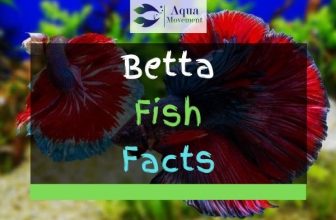19 Best Types of Aquarium Algae Eaters for Freshwater and Saltwater (Fish, Shrimp, and Snail)
So you’ve decided to start keeping an aquarium at home. That’s an excellent choice: fish tanks not only amplify the beauty of your home but also provide therapeutic benefits. A simple act as gazing at fish swim can help to reduce blood pressure and heart rate.
But before you dive in headfirst into the world of fish keeping, there are a couple of things you should keep in mind. More specifically, you should familiarize yourself with the different types of algae and how to keep their growth under control.
The reason for this is that if the algae proliferate beyond a certain level, they may limit the nutrient resources available to your aquarium fish and plants.
If you’re already struggling to maintain the algae to a reasonable count, adding algae eaters to your fish tank is the ultimate solution. In this post, we’ll highlight the best aquarium algae eaters for freshwater and saltwater.
Table of Contents
Siamese Algae Eater

Scientifically known as Crossocheilus oblongus, this is a species of freshwater fish that’s very beautiful to look at. But more than that, it’s relentless at feeding on the algae in your fish tank.
What makes this fish particularly effective for removing algae is the fact that it’s not a finicky eater. Thus, it can destroy the majority of algae found in aquariums.
In case you’re worried about caring for this fish in your aquarium, there’s no need to as they are a low-maintenance species. In addition to algae, they can consume most foods you put in your aquarium including pellet foods and live foods such as bloodworms and brine shrimp.
Type of aquarium: Freshwater
Ideal tank size: minimum fish tank should be 30 gallons
Feeding: Most algae
Compatibility: Most fish
Twig Catfish
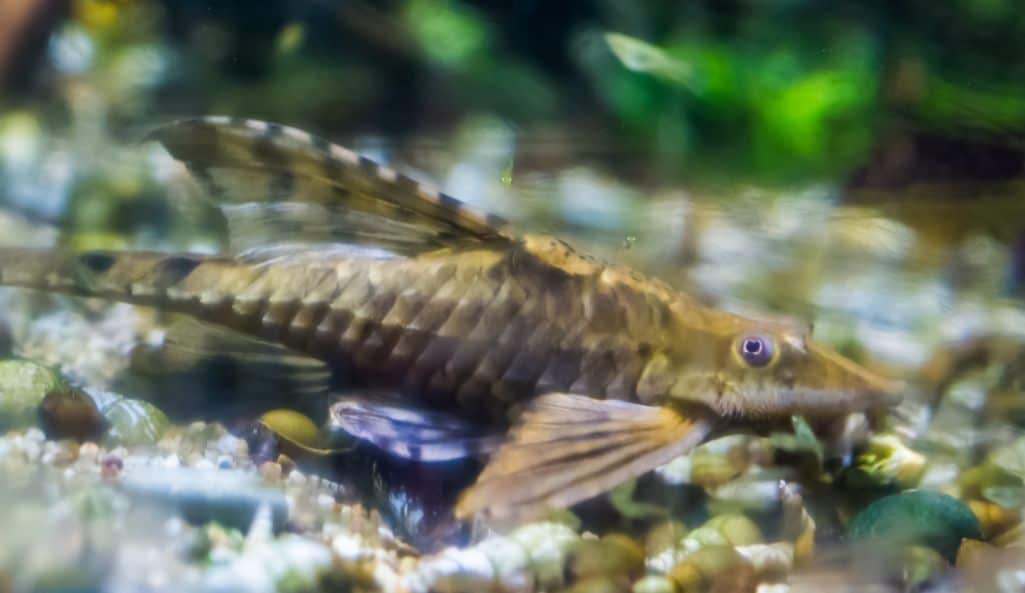
In the category of catfish, the Twig catfish are among the best algae-eating species. Like the Siamese, they can survive on a variety of foods. Better yet, they make quick work of ridding your aquarium of algae.
That said, the Twig catfish require a little more care than other algae-eating creatures. To be specific, they fare well in water with high levels of oxygen, and high current.
Also, they are docile and shy in nature, which means they can cohabit with similarly peaceful species like the tetras and livebearers. However, this also means that they can’t survive in an environment where they’re forced to compete for food. This makes them unsuitable for community fish tanks.
Type of aquarium: freshwater
Ideal tank size: minimum of 20 gallons
Feeding: most algae
Compatibility: should not be kept with very aggressive fish
Bristlenose Pleco
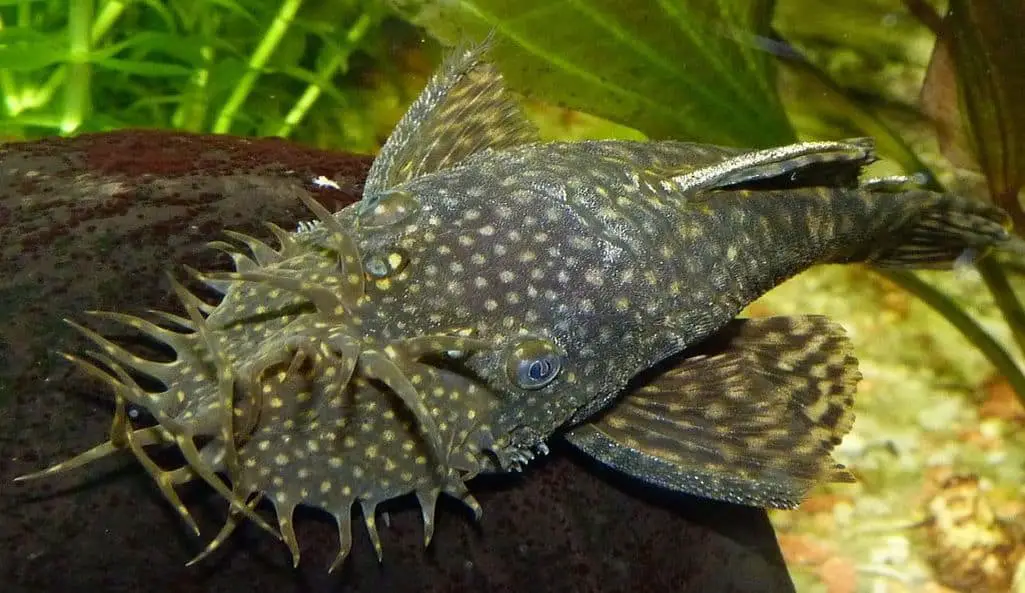
Also known as the Bushy nose Pleco, the Bristlenose Plecos are bottom-feeding tropical fish.
These aquatic creatures grow to around 6 inches long. This poses both a challenge and a benefit. The benefit is that they can consume enormous amounts of algae at once, which cannot be said of fellow algae eaters like snails.
On the downside, it means they require more room to thrive. This also means that they produce a large amount of waste so you’ll need to invest in a top of the range filter.
Type of aquarium: Freshwater
Ideal tank size: 30-gallon capacity and with a large base
Feeding: most types of algae
Compatibility: most fish
Otocinclus Catfish
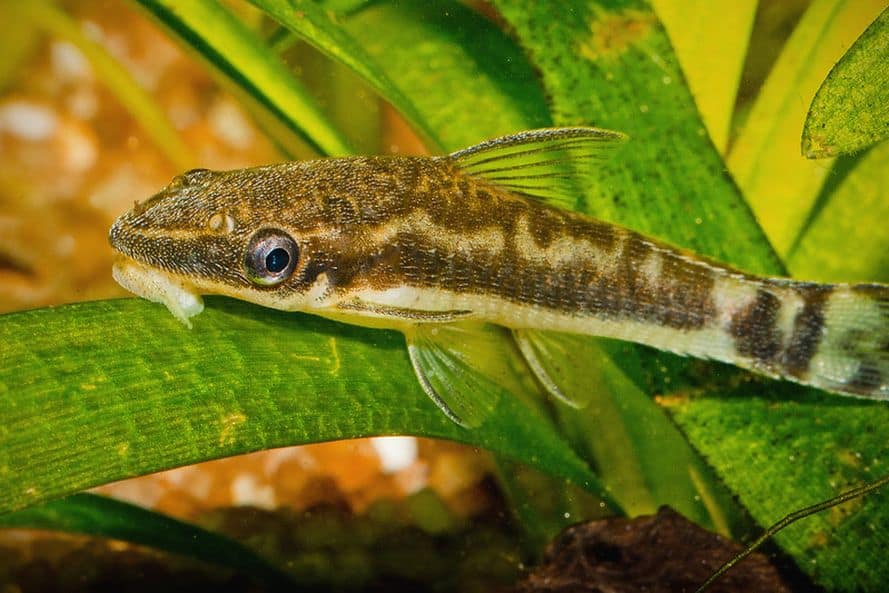
If you’re looking for an algae eater with little maintenance, the Otocinclus Catfish makes a great choice.
You don’t need a lot of expertise to care for these creatures as they’re able to tolerate a range of conditions. Thus, they’re ideal for beginner aquarists who are still learning the ropes around maintaining fish tanks.
Plus, their main source of food is algae, especially the green, soft algae that accumulate on hard surfaces. However, it’s advisable to supplement their diet with algae wafers and a couple of fresh veggies like green zucchini slices.
Type of aquarium: freshwater
Ideal tank size: minimum 30 gallons
Feeding: most algae
Compatibility: peaceful community fish tanks
Ghost Shrimp
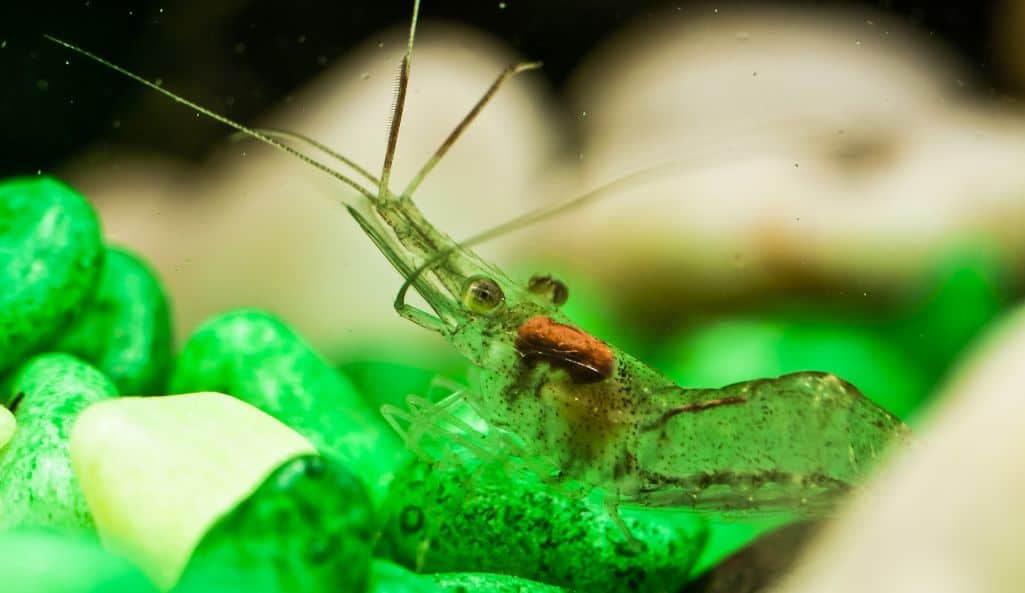
If you prefer an algae-eating shrimp, the Ghost Shrimp is a great choice. Also known as Glass Shrimp, these aquatic organisms thrive in a freshwater environment.
What aquarists like most about these ghost shrimp is that they’re fairly inexpensive and they double up as fish food for the larger fish. However, if you’re buying them specifically to clean up algae, it means that you shouldn’t introduce them in fish tanks with aggressive fish species.
The Ghost Shrimp is best suited for a small tank of about 5 to 10 gallons. Since they’re small, some aquarists make the mistake of adding too many of them in one tank. This should not be the case.
Check Price and Reviews on Amazon
Type of aquarium: freshwater
Ideal tank size: 5 to 10 gallons
Feeding: some forms of algae
Compatibility: a non-aggressive community of small fish
Red Cherry Shrimp
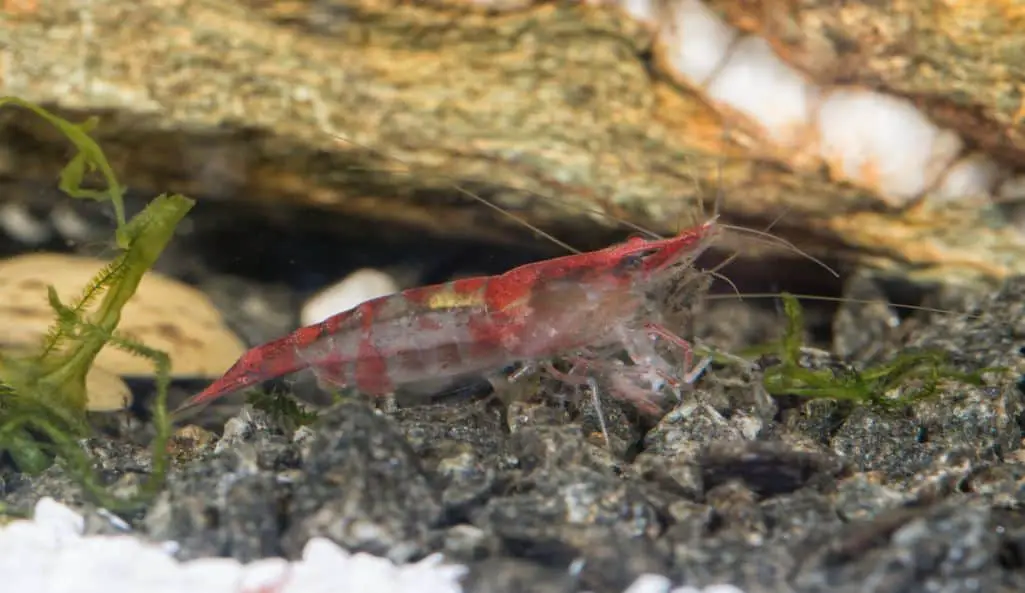
Colorful, calm and easy to care for, the red cherry shrimp is another algae eater worth considering.
These creatures scavenge algae without causing any harm to your aquatic plants. As a matter of fact, it’s said that they eat a variety of algae than any other shrimp- this includes the feared hair algae.
The RSCs thrive in small and big fish tanks. Even the standard 10-gallon aquarium is enough for these creatures to survive. However, they do need good water conditions.
Check Price and Reviews on Amazon
Type of aquarium: freshwater
Ideal tank size: 10 gallons or larger
Feeding: most algae
Compatibility: non-aggressive and small-sized fish
Amano Shrimp

These actually go by a variety of names such as the Japonica shrimp and Yamato shrimp.
The Amano shrimp grows to about 2 inches and feeds on most algae species. These include the brush algae, hair algae, some kinds of string algae and the legendary black beard algae.
However, you need to be tactical if you want to get the most out of these algae-eaters. That’s because they feed well on algae when they don’t have alternative food sources. To get them hungry, avoid feeding them too frequently so they can scavenge on the algae.
Check Price and Reviews on Amazon
Type of aquarium: freshwater; should be heavily planted
Ideal tank size: minimum of 10 gallons
Feeding: brush algae, hair algae, string algae, and black beard algae
Compatibility: peaceful community fish
Guppies

The guppy is also referred to as the rainbow fish or million fish. This is a widely-distributed tropical fish that thrives in a freshwater environment.
What’s interesting is that most aquarists buy this fish for its aesthetics and calm temperament. It’s not until later that they realize that Guppies are also algae eaters.
One point you should keep in mind though is that they’re a proficient breeder. If you don’t want to have too many guppies in your aquarium, then buy only one gender of the fish.
Another key consideration is that guppies cannot survive on algae alone. You should provide them with a range of flakes and live foods like daphnia, bloodworms, brine shrimp, and mosquito larvae.
Type of aquarium: freshwater
Ideal tank size: minimum of 5 gallons
Feeding: benthic algae
Compatibility: peaceful community fish
Snowball Shrimp
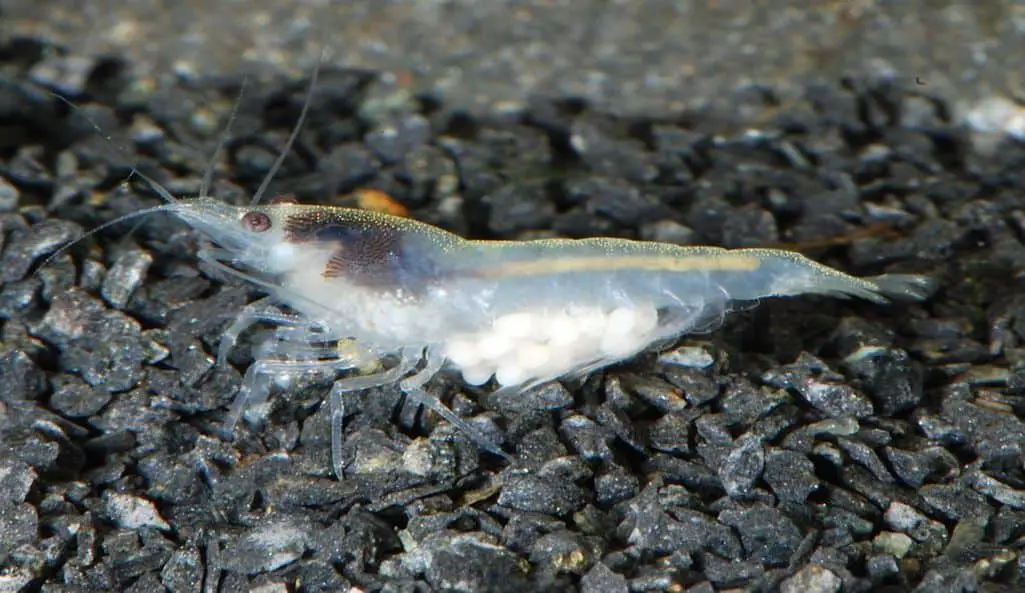
„white pearl“ by DirkBlankenhaus (CC BY-SA 3.0)
Another species of shrimp, the Snowball shrimp make great algae-eaters. Also called the white pearl shrimp, these are fairly easy to care for, meaning they’re a great fit for novice aquarists.
They are not aggressive. Therefore, a peaceful community aquarium will make the ideal home for this species.
As long as the aquarium does not have predators, they will happily graze on any algae present. It’s also a good idea to supplement their food with algae wafers, flakes among other shrimp/fish food.
Check Price and Reviews on Amazon
Type of aquarium: freshwater
Ideal tank size: at least 10-gallon fish tank
Feeding: most algae
Compatibility: non-aggressive aqua-animals
Corydoras Catfish

Popularly referred to as Cory catfish, these are petite living organisms that grow to about 4 inches long. There are actually different kinds of Cories although the most popular is the Bronze Cory Catfish. The good news is that they’re all easy to care for.
Given their minute size, they mainly graze at the bottom of the aquarium. The benefit of this is that they’re not likely to cross paths with the quicker, larger fish that may pose a threat to them.
On their part, the Cory catfish are never aggressive so they can coexist with smaller species of fish.
An important fact to consider is that Corydoras catfish don’t rely solely on algae. In fact, they don’t eat algae as much as other creatures like the Siamese algae eater. Instead, they mainly help to keep the algae levels under control, meaning they’re best suited for maintenance purposes.
Type of aquarium: freshwater
Ideal tank size: 10 gallons
Feeding: some algae
Compatibility: most fish
Nerite Snails

Zebra Nerite Snail by TheJammingYam (CC BY-SA 3.0)
Apart from fish and shrimp, some snails also live off different types of algae. The Nerite snails are a good case in point.
Apart from their huge appetite for algae, these snails have a distinct zebra/tiger-patterned shell that makes them stand out. This explains why they’re a favorite of many aquarists.
Nerite snails are capable of eating just about any species of algae in a freshwater fish tank. By this we mean even those algae that are incredibly difficult to get rid of like the green beard algae and green spot algae.
Unfortunately, they only grow to around 1 inch long. Their small size makes them susceptible to predatory fish. For this reason, they’re best suited for smaller aquariums.
Check Price and Reviews on Amazon
Type of aquarium: freshwater
Ideal tank size: 10 gallons
Feeding: most types of algae in freshwater
Compatibility: should not be kept with larger predatory fish
Mystery Apple Snail

If you have the assumption that all snails are small, you’ve probably not encountered the Mystery Apple Snail.
The shell of this snail is between 1.5 and 2-inches wide with a diameter of 1.7 to 2.5 inches. To put this into perspective, they have a diameter that is as big as that of a baseball. What this means is that you should ensure you have enough room to accommodate them in your aquarium.
The Mystery Apple Snails rely on algae for survival. And while they’re known to much on all kinds of algae, their favorites are substrate algae, plant algae, and aquarium glass algae. Often, you’ll see at the bottom of the fish tank grazing algae on the substrate and hunting for leftover food.
Keep in mind that these snails can turn to live aquatic plants if there are not enough algae to feed on. So ensure they have enough vegetation to eat.
Adult Mystery Apple Snails can fend for and protect themselves. However, the smaller ones may become prey to the large predatory fish.
Check Price and Reviews on Amazon
Type of aquarium: freshwater
Ideal tank size: 10-gallon or larger
Feeding: aquarium glass, substrate, and plant algae
Compatibility: certain fish like Tetras, Guppies, and Killifish as well as other peaceful invertebrates
Ramshorn Snails

If you’re dealing with a planted aquarium, using Ramshorn snails as your algae eaters is a superb option.
Why we recommend these creatures is because unlike other algae-eaters, the Ramshorn snails won’t cause any harm to the other non-algae plants. As long as the algae count is high and there’s enough dead plant matter, the snails will be too busy to bother your aquatic plants.
The Ramshorn snails get their name from their appearance. They resemble the horn of a ram, and they come in either a red or brown color. Growing to around 1 inch in length, these snails thrive in an alkaline environment.
If you add an acidic element to the aquarium, there’s a high likelihood that their shells will dissolve. So it’s vital that you check the water’s pH and keep it at a steady 7.
Check Price and Reviews on Amazon
Type of aquarium: freshwater
Ideal tank size: 5 to 10 gallons
Feeding: soft algae, decaying plant matter, fallen tank mates
Compatibility: a peaceful school of fishes and prawns
Malaysian Trumpet Snail
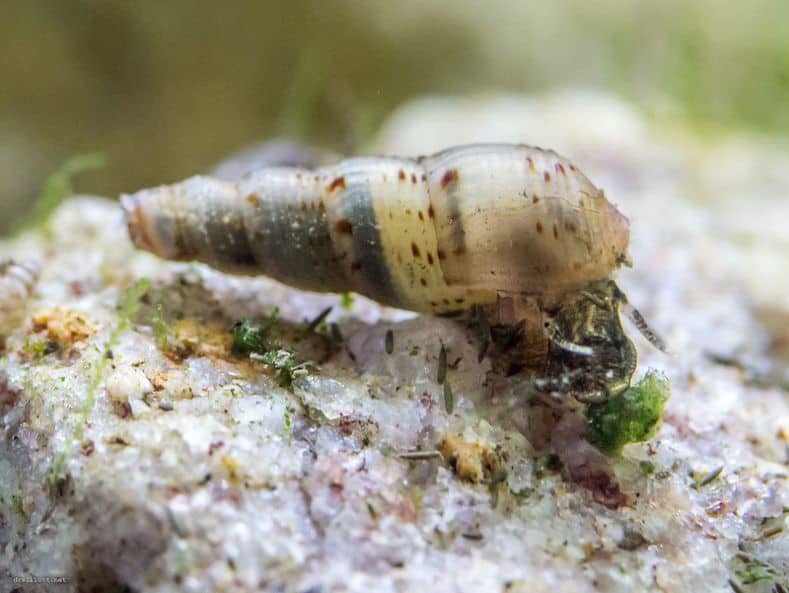
Another type of snail that’s really effective at keeping your fish tank clean is the Malaysian Trumpet Snail. These are fairly small, growing to only about 2 cm.
In addition to leftover fish food and vegetation, these creatures feed on all kinds of algae. Contrary to the Mystery Apple Snails, these ones don’t turn to live plants in dire times. So if your aquarium is brimming with live plants, the Malaysian Trumpets will make a great companion.
Check Price and Reviews on Amazon
Type of aquarium: freshwater
Ideal tank size: 3 gallons
Feeding: soft algae that build up on hard surfaces
Compatibility: coexist with most fish except larger species that pose a risk
Chinese Algae Eater

If you have a big aquarium with a capacity of 50 gallons or more, then you need an equally capable algae eater like the Chinese Algae Eater.
While they may look small initially, these fish grow to up to 28 cm or more. They also grow pretty fast, and this means they’re only meant for large-sized tanks. Once they mature, they have an uncontrollable appetite for algae.
An unpleasant fact is that these fish tend to get very territorial as they approach adulthood. For this reason, they’re ideal for fish tanks with only a couple of different species.
Type of aquarium: freshwater
Ideal tank size: at least 50 gallons
Feeding: all types of algae
Compatibility: not compatible with larger flat-bodied fish species like the Angelfish
Best Types of Aquarium Algae Eaters for Saltwater
1. Surgeonfish

Scientifically known as Acanthuridae, the Surgeonfish feeds exclusively on algae. This makes them an excellent addition to your coral aquarium.
If you look at the Surgeonfish closely, you’ll notice that its caudal fin is crescent-shaped. What is even more unique is the erected portion of the spine located near the tail. Often described as the “surgeon’s scalpel”, the fish use this part to defend themselves.
That said, you should pay attention to their behavior. If they start to fight, they may cause harm to their fellow tank mates. However, they are not an aggressive species, and will happily cohabit with most types of fish.
Type of aquarium: saltwater
Ideal tank size: 180 gallons
Feeding: all types of algae
Compatibility: most fish
2. Lawnmower Blenny

When it comes to the sheer appetite for algae, few creatures can rival with the Lawnmower Blenny. This aquatic creature lives in marine tanks and feeds primarily on microalgae.
Also referred to as the Algae Blenny, these living organisms can be found in an array of colors including black, brown, orange and yellow.
For them to thrive and serve the function you bought them for, you’ll need to keep them in a properly-sized tank of at least 30 gallons. The fish tank should also have a number of scattered rocks where they can perch and hide. Plus, you should only add one Lawnmower Blenny per tank as they tend to fight each other.
Type of aquarium: saltwater
Ideal tank size: minimum 30 gallons
Feeding: microalgae
Compatibility: sometimes, they eat small polyp stony coral
3. Rabbitfish
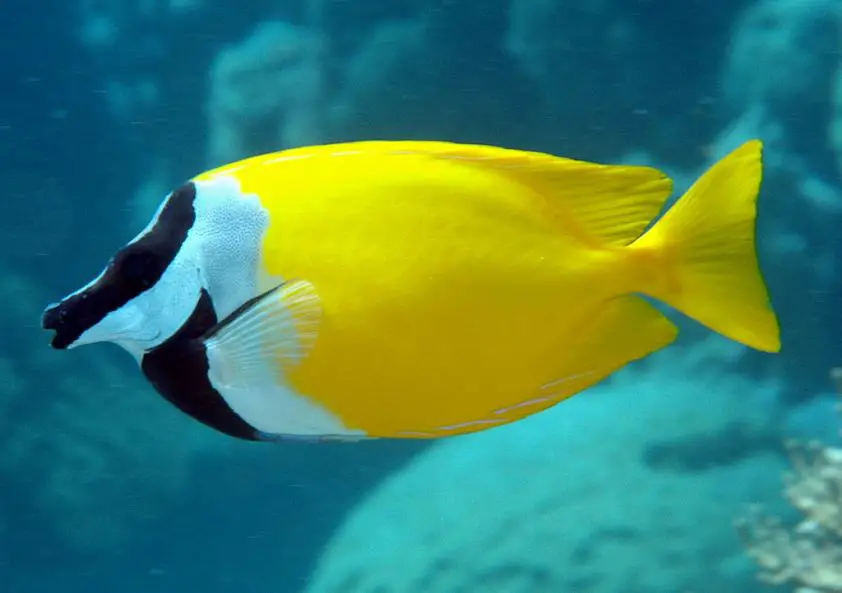
leonardlow (CC BY 2.0)
For those with saltwater aquariums, aquatic creatures like the Rabbitfish make strong contenders as algae grazers.
Aptly named because of their enormous eyes and small, rabbit-like mouths, these fish are pretty good at controlling nuisance algae. They grow to about 9 inches and are highly active during the day.
Rabbitfishes are usually peaceful; hence make great tank mates for a community of tropical marine fish. They’ll get along well with the majority of aquatic creatures, as long as these counterparts are not aggressive.
An exceptional attribute of these fish entails the spines on their tail fins. Not only are these spines grooved but also venomous, so the fish can attack when threatened.
Type of aquarium: saltwater
Ideal tank size: 75 gallons or more
Feeding: most algae such as caulerpa, bryopsis, valonia, hair algae, and red turf algae
Compatibility: most fish
Best Freshwater and Saltwater Aquarium Algae Eater
Molly Fish (Mollies)
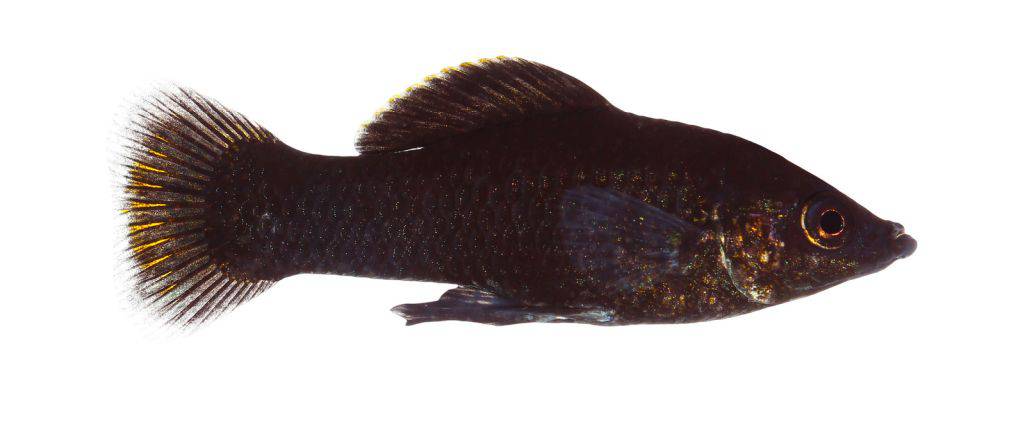
When aquarists think of the best algae eaters, the molly rarely crosses their minds. But the truth is, these fish are very effective at cleaning up algae from your fish tanks.
The best part is: they can thrive in both fresh and saltwater aquariums if they are acclimated slowly. Another trait that makes them suitable for this role is the point that they’re not overly aggressive. They have the capacity to protect themselves, so they make excellent tank mates.
Type of aquarium: freshwater and saltwater
Ideal tank size: 20 gallons and above
Feeding: most algae, especially the kind that grows on rocks and plants
Compatibility: tiny, peaceful community fish
Common Types of Algae in Aquariums
In order to determine the ideal algae eaters to add to your aquarium, you should learn the different kinds of algae that exist in fish tanks. They include:
Green Algae
The green-colored algae are the most popular, and they’re a sign that the water in your aquarium is in good condition. They’re often regarded as the “good” algae. There are aquarists who allow this kind of algae to increase significantly. One of the reasons for this is because they’re an excellent source of food for fish.
But even then, you need to keep their numbers under control so they don’t end up depriving your tropical fish of necessary nutrients.
Besides, a high number of them can cause water to turn green and murky. This, in turn, inhibits living organisms in your fish tank from accessing natural sunlight.
How to get rid of Green Water Algae in Fish Tank
Blue-Green Algae
These look fairly similar to the green algae. However, this kind of algae signals poor water conditions in your aquarium. Blue-green algae are not a plant species per se, but rather a type of bacteria called cyanobacteria.
These tend to develop in sheets and emit a terrible, musky smell. If your aquarium has this type of algae, it could be because of several reasons. These are excess amounts of organic waste and phosphate in the water or too much light. They could also be the result of poor maintenance of your fish tank or overfeeding your fish.
4 Ways to get rid of Blue-Green Algae in Aquarium
Brown and Red Algae
The brown and red-colored algae are particularly common in newly-installed or saltwater fish tanks.
This is because ensuring the right chemical make-up of water in such aquariums is challenging. Perhaps the phosphate levels are too high. Or, maybe there’s very little light reaching your aquarium.
A common reason why brown and red algae end up increasing to extreme levels is that they’re sometimes mistaken to be diatoms.
Diatoms are microscopic organisms that are known to excrete calcium. These act as the breeding grounds for most algae. And unlike brown and red algae, diatoms are incredibly difficult to get rid of.
Staghorn Algae
They staghorn algae have a very distinct look- grow in such a way that they branch out and look like clumps of hair.
These kinds of algae like growing near or around fish tank equipment like water filters. Like diatoms, they’re particularly difficult to remove mechanically. An easier way to eliminate staghorn algae is to use bleach.
One way to get rid of stubborn algae is to use an aquarium UV sterilizer. This piece of equipment eliminates all free-floating microorganisms; hence, prevent an algae bloom (dramatic increase in algae count). The other option is to introduce naturally-occurring algae eaters like the ones we’ve reviewed in this post.
Final Verdict
As an aquarist, one of the things you have to do is keep the algae population in check. If they’re increasing rapidly, you can reduce their numbers by adding one of the best algae eaters.
This way, you’re guaranteed that the algae aren’t depriving your aquatic plants and/or animals, the essential nutrients they need to survive.
7 Aquarium Algae Types – Freshwater and Saltwater




